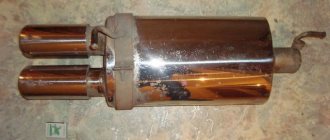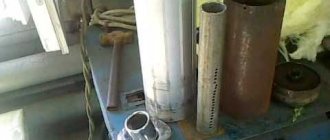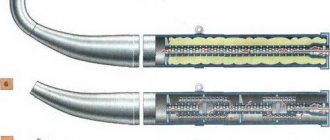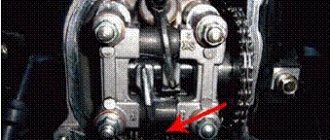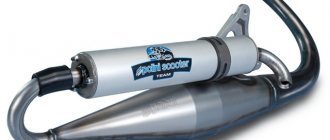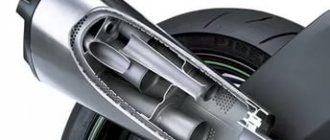Our qualified car service center “Leha Exhaust” provides full service of exhaust systems of motorcycles such as: Harley Davidson, Suzuki, Yamaha, Honda, Kawasaki, KTM, Husqvarna
Manufacturing of exhaust systems for motorcycles in Moscow
We will manufacture and install a custom exhaust on a motorcycle
Motorcycle exhaust system tuning. Photos before work began
Photo after tuning. Muffler - our client's choice
Stainless steel motorcycle exhaust system
We will make an exhaust for a motorcycle in Moscow at a low price
Tuning the exhaust system of a motorcycle in Moscow - car service "Leha Exhaust". Come!
You can see even more photos of exhaust systems in our gallery
Page navigation:
Motorcycle exhaust services
Motorcycle exhaust problems
Motorcycle exhaust system tuning
How to install
The first thing you need to know is what is required to work with the exhaust system. You will need to carry out a procedure to help avoid conflicts with others regarding the sound of your vehicle. In short, it implies professional improvement aimed at achieving a sporty sound. Regarding the pipes, they must be made of temperature-resistant material, since the gas leaving the engine will be very hot and the pipes must withstand it. In order to do everything yourself, you will need to find the appropriate muffler. A standard one may be suitable if it is in good condition.
It is also important to select a pair of pipes of the required dimensions and a special noise absorber. Below is a diagram of the type of muffler under consideration, where the number four indicates the mentioned absorber
Services
We provide the widest range of services in Moscow for motorcycle exhaust systems
- Manufacturing and selection of exhaust manifolds
- Exhaust Sound Adjustment
- Direct flow installation
- Replacing or removing the catalyst
- Muffler replacement, cleaning and repair
- Manufacturing of exhaust systems according to individual projects
Most often, our customers turn to us to replace stock elements with high-quality Akrapovic exhaust system components, of which we are the official distributor.
Is a resonator needed or not?
Now let's look at a detail such as a resonator. Is it needed at all? This part is responsible for the timely exit of burnt gases from the engine chamber. This will free up space for new gases to enter, thereby making the engine run faster. Almost all experts agree on one thing - the engine power depends on the quality of the resonator, so this detail is very important. And when you hear that sports models have undergone modernization, this primarily concerns the resonator. Of course, the standard exhaust system has a resonator, but it is replaced with a more advanced one.
The resonator must be located behind the forward flow in order to absorb the main flow of toxic gases coming from the engine. And the more efficient the resonator’s operation is in this case, the better the car’s driving performance will be.
To better understand the essence of how a resonator works, you need to understand its multilayer design. Each of the layers of the resonator performs a specific function, its own type of work. For example, the air filter level consists of reflectors, which, in other words, dampen air flows.
In addition, the efficiency of the resonator depends on three important components. These are the cleanliness of the muffler, the condition of the catalyst and the diameter of the pipes.
Manufacturing of a direct-flow muffler
There are two types of resonators for muffler. Resonators are common for two-pin and four-pin motors. Each has its own advantages and disadvantages.
In particular, during operation it was noticed that the resonator for a four-pin motor is more of a hindrance than a helper. Removing the resonator from this type of muffler means that the engine power increases by as much as 15%.
On the other hand, if there is no resonator in a two-stroke engine, not only exhaust gases will escape into the muffler, but also the remains of unburned fuel. In general, there will be a loss of speed with a simultaneous increase in fuel consumption. It is clear that this option will not suit anyone.
To increase engine power, the exhaust system must be configured in such a way that the resistance to the exit of gases is reduced and a vacuum is provided during intake.
Let's start with exhaust gas resistance. By installing a direct-flow muffler, you can solve this problem one hundred percent. The resistance of the exhaust system is reduced, and at the same time favorable conditions are created for the absorption of the air-fuel mixture into the combustion chamber.
How does this happen? It's simple. Direct flow creates less resistance to the escaping gases, which now leave the combustion chamber more efficiently. This, in turn, allows it to quickly take its place in the air-fuel mixture chamber. It is clear that as a result this will affect the engine power.
Types of mufflers and their differences
There are 4 types of mufflers based on the method of absorbing acoustic waves:
- reflective;
- restrictive;
- absorption;
- resonator.
The reflective circuit is reverse-flow, the rest are direct-flow.
Reflective
If one muffler is installed in a car, then a reflective version is used. It uses the principle of “breaking” the flow of exhaust gases by creating several partitions, expansion chambers and turns. Exhaust volume is reduced to standard levels. For this reason, the vast majority of factory vehicles are equipped with the reflective type.
The disadvantage of this type of muffler is the reduction in engine power due to the resistance of the exhaust system to the flow of exhaust gases.
Resonator
A resonator muffler is installed as the first stage in the exhaust system of powerful engines. It consists of a perforated pipe placed in a housing. The body is divided into two or three sections. The energy of the exhaust gases is weakened due to a stepwise reduction in pressure.
The part reduces the force of sound vibrations and maintains engine power with a free flow of exhaust gases.
Restrictive
In restrictive mufflers, the gas flow passes through a diaphragm or cone narrowing, which leads to a decrease in engine power. The acoustic protection of such devices is low, since the diaphragm does not interfere with the rectilinear movement of the sound wave.
Absorption
The damping function for sound vibrations in the absorption muffler is performed by a finely porous non-flammable material located in the space between the perforated pipe and the housing. The design is similar to the resonator type. This type has little effect on power reduction.
Posts 1 page 30 of 67
Share22012-02-10 16:14:17
So much I want to say and so little time! It all started, as you already understood, with the modification of the manifold to an increased diameter of the pipe for better exhaust gases and reduced flow resistance. It was logical to continue the refinement and make a direct-flow muffler. Which is actually what I did the other day! Something like inspiration came to me. At first I began to develop the future concept in my head, but how often does it change during the work process! I wanted to find a seamless pipe without seams (this was the first snag). There weren’t many options until I saw an ordinary fire extinguisher at work. And then an idea appeared and began to develop rapidly in my head! Since the total length of the muffler, according to my calculations, should be at least 400 mm, and fire extinguishers with such a length are too thick, it was decided to take two small ones and make a completely assembled (dismountable) muffler. As I already said, two old unnecessary fire extinguishers were taken, the powder was released and the valves were unscrewed. Then they cut off the back parts. It looks like this:
What’s most interesting is that the muffler ITSELF will look like this:
Then you need to somehow make the ends on the muffler; for this, 6mm thick sheet metal was taken and two pancakes were cut out, which were then turned into flanges! Why such large holes, you ask? So that later you can safely insert tubes of DIFFERENT DIAMETERS. on both sides and fill with refractory material. The flanges will be tightly welded.
Pipes of different diameters will be inserted into these two jars! Why is this done, you ask? I want to achieve only low frequencies and get rid of high frequencies. A pipe with a diameter of 70mm will be installed at the outlet, and a pipe with a diameter of 40mm will be installed at the inlet to the muffler. The joint in the form of a narrow transition in the middle will cause a curvature of the flow of passing gases! The holes in the tubes will also be of different diameters. That's all for today.
Not tuning, but restoration
However, modernization is not the only way for owners of the popular model. After all, the age of many motorcycles has already exceeded two decades, which means that they can already be classified as rare. Restoring IZ Jupiter-5, restoring it and bringing it to its original state is also quite justified.
A legendary motorcycle that looks like it just rolled off the assembly line yesterday will attract no less attention than the tuned version. It’s just that how to properly restore equipment by performing qualified repairs often turns out to be much more difficult than remodeling it to your taste.
Why do motorcyclists need forward flow on a motorcycle?
The exhaust system is designed to perform several tasks.
Exhaust gases are removed. The exhaust gases better fill the engine cylinders. And dampens the noise. The spent mixture leaves the cylinders at a very high speed and therefore creates a loud noise. It is the muffler that reduces the noise of exhaust gases due to the obstacles installed in it. A direct-flow muffler or direct-flow muffler on a motorcycle produces a peculiar engine roar and is not accepted by many people. It is believed that motorcycles with such a muffler disturb people and pollute the atmosphere.
Motorcyclists who promote quiet riding in the city do not accept straight-through mufflers. But experienced bikers are sure that forward flow is not only passive safety, but even active safety on the roads. How? The fact that you can indicate your location in the traffic.
Sometimes it is difficult to show some drivers even with a signal or headlights that you are nearby. And only the roar of the muffler helps to do this. And it happens that the sound of the muffler stops the driver from a careless maneuver that could lead to an accident.
How to make a muffler for a motorcycle is a question asked by many owners of motorcycles, especially domestic ones, whose appearance of standard factory mufflers leaves much to be desired. The need to make a homemade muffler may even arise among owners of imported motorcycles, for example, when tuning them (customizing). You can, of course, pay a certain amount of money and buy ready-made mufflers from some company, but often they are not suitable for some models of bikes and their mountings have to be redone. Yes, and they cost a lot. In this article we will look at how to make mufflers for a motorcycle with your own hands, on a minimal budget, and what you will need for this. In general, in one article it is simply not possible to describe the manufacture of mufflers for all types and models of motorcycles, because all bikes are different, the mounting points for mufflers are different, and there may be several options for the shape of mufflers and their mounting points, even for one motorcycle model. But still, having described the manufacture of a muffler of a certain type and shape, this will serve as an example for the manufacture of any other exhaust pipes and mufflers, because the manufacturing principle is almost the same, with the exception of some small details (pipe diameters, sizes and attachment points of pipes).
Below we will describe the manufacture of two different versions of mufflers, which differ in their internal design. That is, I will describe the manufacture of an ordinary quiet muffler with partitions, similar to the factory one. And the manufacture of a direct-flow muffler will also be described, which will add power to the bike, but will also sound louder. And so let's go.
Muffler for moped: types, features and tuning
What is a muffler and what is it used for? The goal is to acquaint you not only with how to construct a homemade muffler for a scooter with your own hands, but also with the purpose of this important unit.
Two stroke and four stroke scooter
A scooter, as you know, can be with a two-stroke or a four-stroke engine. The operating principle of the entire exhaust system differs radically among analogues.
The muffler on a four-stroke scooter removes gases in a relatively shorter time, doing this with minimal noise. In addition, tuning the muffler in this case will be quite simple. On the other hand, in both cases, when carrying out tuning, it will be necessary to change the pipes.
Types of mufflers for scooters
For the muffler of a two-stroke scooter, selecting components that make it possible to carry out tuning will be much more difficult. The standard muffler itself for such scooters is more difficult to manufacture and configure.
The exhaust system of a two-stroke scooter works as follows. During the process of cleaning exhaust gases, part of the power is returned to the engine. This happens at certain speeds and if you manage to implement this whole process by tuning, the scooter will be unrecognizable.
You can install a high-quality and correctly tuned resonator on a two-stroke scooter. This will give a noticeable increase in dynamics up to a quarter. But in this case, it will be important to carry out professional settings of the entire power system.
Why do you need quality mufflers?
As you know, a certain amount of fuel combustion products accumulates in the cylinders of a moped engine. They must be thrown out and in this case it is the muffler that is responsible for this. In other words, this unit seems to smooth out the pulsations that are inevitable when combustion products are released at high speed.
The very design of the muffler, used not only on scooters and mopeds, but also on motorcycles and cars, implies a special exhaust system, which can be different, depending on what result the vehicle owner wants to achieve. For example, if the desire to improve the gas exhaust system is related to increasing the power of the scooter, a special type of muffler is required - a direct-flow muffler.
Direct flow type muffler
Direct-flow muffler device for moped
Installing this type of muffler will not only increase dynamic power, but will also significantly increase the noise emitted when gases escape. On the one hand, this is good, because this way you can attract the attention of other drivers, thereby increasing passive safety. As you know, drivers of large cars often complain that they do not notice motorcyclists, and mopeds and scooters even more so.
Making such a muffler from scratch or using a method that involves tuning is not difficult, but many technical aspects need to be studied.
Features of a direct-flow muffler
The features of direct flow are as follows: exhaust gases are ejected outside the engine immediately, the cylinders of the power unit have time to fill with the fuel mixture in the optimal amount.
I would like to remind all readers that at the moments of intake and exhaust, engine valves tend to open and close. Between these stages, a vacuum occurs, which allows the cylinders to be cleared of exhaust gases. As a result, free space is freed up, where the fuel mixture is supplied. It is easy to guess that the faster the cylinders are released from exhaustion, the faster they will be filled.
Cleaning the muffler
The cleanliness of the muffler affects the power of the moped
Before you start changing anything in the exhaust system, I would like to give one piece of advice. The power of the scooter is directly affected by the cleanliness of the muffler. If it were possible to see the exhaust in a cross-section of the muffler, the owner of the scooter would be very surprised. After a certain mileage, the scooter's dynamics decrease, and owners begin to look for the reasons for this, finding them in a complete rework of the standard muffler or its replacement.
The reason for the loss of power, meanwhile, may be hidden in the condition of the engine itself. This will help determine the specialist you should contact before tuning. But the most common cause of loss of dynamics is soot that clogs the muffler. In this case, it is recommended to carry out cleaning in three ways.
First method: mechanical
It involves cleaning the muffler section (it is done with a grinder). The inside of the muffler is cleaned of soot using a wire or cable. The section in the section is closed by welding.
Second method: chemical
It involves pouring water with some kind of cleaner into the muffler. For example, caustic soda is suitable for this purpose. This cleaning has the advantage that the appearance of the muffler will not be affected in any way.
Third method: heat treatment
The muffler is heated either on the scooter with a blowtorch, or dismantled in an oven or on a grill. It will be necessary to repaint the muffler only after it has cooled.
Making a resonator in real life 350 638
Dimensions of resonator parts designed for different speed ranges of the JAWA 638 motorcycle
Program for calculating resonators in Java, etc. download
1 way. A more labor-intensive method is to shorten the elbow according to its estimated length, and make the straight cone curved, dividing it into small cones. Photo of the resonator below:
Method 2. Less labor-intensive - we shorten the elbow so that a straight cone can be attached to it. Then we make several longitudinal cuts from the end of the knee to the place where the calculated knee should end.
The cut parts must be expanded so that they form the beginning of a straight cone. You will also have to cut “patches” to connect the cut parts. Photo of the resonator below:
You can scan metal using the setup-cone program. Download
DIY saxophone muffler for scooter
Even with minimal tuning of the scooter, you need to think about installing a resonant exhaust. The operating principle and review of saxophones, as such mufflers are popularly called, will be given in another article.
A resonant saxophone muffler is not a cheap thing and not everyone can afford it. Accordingly, scooterists have a desire to save money and make such an exhaust pipe on their own. In this article you will learn how to make a primitive homemade saxophone using the example of a Yamaha Jog scooter. Why primitive? Because with this method we will not carry out calculations of the resonator (this requires a special program), but will simply use a drawing of a saxophone muffler.
The drawing shows the dimensions of the saxophone muffler for the Yamaha Jog.
How to Make a Yamaha Jog Saxophone Silencer
So let's get started. To make a saxophone, we need metal approximately 1.2 mm thick. It must be cut according to the dimensions indicated on the drawing (You can adjust these dimensions closer to your parameters). In order to accurately bend the metal, we grind a wooden blank to size (we get a kind of wooden muffler) and then bend the steel according to this shape. After carefully adjusting the workpiece, we weld the joints using semi-automatic welding. We clean the part using any available means.
We also bend the muffler and muffler pipe. On one side we weld it completely, and on the other side with rivets (to replace the filler, here it is glass wool). After welding, we check all elements for leaks - there should be no gaps, of course.
We sand all the parts and paint. In this case, the muffler is painted with powder paint, and everything else is painted with simple acrylic paint.
The fastenings on the muffler are made of stainless steel.
And here is the result of our painstaking work - a copy of the Tecnigas saxophone. Not bad, right?
A saxophone on a scooter looks even better.
After installing such a muffler, you may need to adjust the scooter's carburetor, adjust the transmission as a whole, and the engine in general.
Calculation and production of a resonator in reality 350 638
L=((118+164)/720*1/5250*3360)/2=1.24m = 1240mm
The length of the elbow should be within 20-28% of the total length of the exhaust system: (1240*28)/100 = 350mm The length of the straight cone should be 32-38%: (1240*32)/100 = 400mm The length of the middle part is accordingly 8 -10%: (1240*10)/100 = 120mm The length of the reverse cone is respectively 30-35%: (1240*30)/100 = 370mm The diameter of the elbow is 63-70% of the diameter of the cylinder, which is 58mm: (58* 65)/100 = 38mm , i.e. corresponds to the diameter of a standard JAVA elbow. The diameter of the muffling part is 65-75% of the diameter of the elbow, i.e. 25-28.5mm We will calculate the diameter of the middle part using the formula given in the article: 38+0.21*400 = 120mm
How to get the most out of a scooter with tuning?
Scooter tuning is a fairly extensive process, but consists mainly of styling (improving appearance), chassis tuning (modifying driving characteristics) and engine tuning. The last point consists of many different operations that are aimed at increasing engine power, its better implementation and increasing acceleration and maximum speed. Below we will consider modifications to the engine and transmission.
It’s worth noting right away that the scheme is general and suitable for Italian, Japanese and Chinese models. Those who doubt the quality of Chinese scooters should be reminded that the level of production of modern models from the Middle Kingdom has increased significantly over the past 10 years, and most of the spare parts on the market for all models are from Chinese manufacturers.
There are many ways to speed up your scooter and, first of all, they depend on the current technical condition of the unit. Let's take, for example, an old scooter with an incorrectly configured variator, a clogged air filter, a dirty carburetor and a number of other problems that arise when the equipment is not properly maintained. Such an engine has great potential, but it can only be realized after proper tuning. After thorough cleaning and adjustment of all systems, even standard engine performance will seem like a significant improvement.
It follows that any work aimed at improving driving performance must begin with a complete revision of the engine.
Removing factory limiters is a very popular type of tuning and quite simple. Most of the Japanese equipment and similar Chinese equipment comes from the factory with special limiters that do not allow the engine to operate at full power. Fortunately, you can get rid of restrictions in any garage, and any tuning of a scooter with your own hands begins with the elimination of such restrictions.
When childhood illnesses are over, it is worth paying attention to real tuning, namely, improving or modifying existing components and assemblies. We are talking, of course, about the cylinder-piston group, carburetor, muffler, variator, air filter and ignition system
At this stage, the degree of involvement in improving a particular element depends on the budget. If funds are limited, then we will make the most of the existing set by modifying the described units.
If you have a certain budget for tuning, you can go the route of replacing parts with special tuning ones. Special parts designed for such modifications automatically improve the basic characteristics of the engine, plus they are designed for higher loads. We have figured out the general scheme of improvements, and below we will look at how tuning occurs, using examples of specific components.
All homemade products
If you have an old but indestructible Japanese scooter, which, unlike the rotten Chinese one, does not shine with chrome, but deserves to look beautiful and dignified like no one else. So let's give the muffler a new look.
We will need very simple materials:
- A small sheet of thin stainless steel, 0.4-1 mm thick.
- A piece of rolled heat-resistant sound insulation, ~5 mm thick (asbestos or other)
Tools:
- Semi-automatic welding.
- Grinder with a thin disc of 1 mm.
Lyrical digression.
Over time, even the most famous manufacturers of motorcycles, in my case it’s Honda, completely clog the muffler with exhaust carbon, after which the engine completely stops starting and we are left with only two options, buy a new Chinese muffler or disassemble and clean the old one.
But since Chinese mufflers in most cases are just an empty and thin can, in which there is absolutely no system of reverse wave resonance, and for a two-stroke engine this is a sentence for a loss of power of up to 50% and, as a result, the scooter completely stops driving!
Therefore, I recommend everyone to choose the second option - cleaning, not replacement, well, unless it’s the Original!
When sawing the muffler canister for cleaning, out of hopelessness, it is necessary to remove the internal fiberglass noise insulator of the body, after which the sound of the operating scooter becomes louder and more unpleasant (ringing), the body can resonates, and also the appearance of the muffler suffers and is no longer as neat as before.
Therefore, this tuning kills two birds with one stone: decorative decoration of the muffler and additional noise insulation, which completely returns the noise level to the new norm.
Manufacturing and assembly.
Unscrew the four nuts and remove the muffler.
We measure the circumference of the muffler and its length between the welds.
To the resulting dimensions of the circle we add 2-3 cm for the joint, and to the width we add 2 cm for the bends. We cut out a calculated rectangle from thin stainless steel.
On the wide sides we make bends of 5 - 6 mm. It is enough to place it on the corner, secure it with two clamps and tap it with a hammer.
Immediately polish the surface, for example with GOE paste.
Thin 1mm. Using a disk, we make cuts to the entire height of the bend, in increments of 5 mm.
We remove sharp edges and burrs.
Using the resulting dimensions, we cut out a piece of noise insulator (for example, asbestos weave, fiberglass, etc.) so that it fits tightly inside between the bends and a length equal to the circumference of the muffler can.
We wrap this “sandwich” around the muffler can so that the joint is inward towards the wheel.
For convenience, we compress and secure it with clamps or other fasteners (for example, rubber rings, belts).
We do spot welding.
We remove the fasteners and install the muffler back on the scooter.
Let's start it!, enjoy how quietly it runs and admire the shine of the new plug!
Making a direct-flow muffler from scratch
You can make such a muffler from scratch. This will be a completely new version made from several components. The difficulty of this operation, called tuning from scratch, lies in finding the diagram of the exhaust system of a particular moped.
Tools and materials
In this case, again, you need to prepare the necessary tools and materials.
- Purchase in a store or find two pipes with a diameter of 33 mm;
- Buy plexiglass;
- Bolts M8 and M3;
- Prepare glue and nails;
- Welding machine;
- Needles;
- Hacksaw for metal.
Let's start assembling
First of all, you need to cut 18 cm from one of the pipes. It is recommended to carefully process the place in the cut with a needle file. From the second pipe we cut a circle with a diameter of 1.5 cm. We process it using the method described above. Glue the cut out circle in the section of the first pipe. We cut off another piece of pipe, 18 cm long. We make many holes in it. This can also be done with a sharp nail.
We connect all the parts using a welding machine. We fill the cavity formed at the junction of two pieces of pipe with mineral wool. We wrap the finished product with a special fire-resistant material. The homemade muffler is ready. To install it, you will need to attach the element to the scooter body mount.
Making a muffler mounting element
From plexiglass, which is indispensable in this matter due to its strength and easy paintability, we cut out a special type of ring, the edges of which can be bent outward by 180 degrees. We attach the resulting circles with serifs to the moped using the required bolts. We polish the muffler using sandpaper. To be sure, the joints between the homemade product and the moped body will need to be lubricated.
Homemade muffler for moped disassembled
If homemade production causes certain difficulties, you can find a lot of models of mufflers already in finished form. They are usually inexpensive. On the other hand, only a homemade version can provide the ideally expected option.
Good evening everyone, blog readers... Today there will be an interesting entry, but first of all it will be of interest to those who have mopeds and light motorcycles... Now I will tell you how, without any collective farm work and sawing the muffler and similar things, you can make a pleasant exhaust and a sound that you will like even with Every turn of the throttle, the sound will amaze you more and more... I read a bunch of articles and everything about this, I also watched a bunch of videos of how they cut off the original muffler, drill holes in it, and so on... In short, I am an opponent of such tuning, it’s just stupid... By Therefore, we decided to come up with and create a structure ourselves that will not only be installed, but can be removed... And so, if you are ready, let's begin...
One day I turned to my friend Zelencoff to come up with something to change the exhaust sound to a more pleasant one... I’m just the kind of person who loves a pleasant exhaust sound, I can listen to it for hours. For example, on my car I have a home-made muffler from a GAZelle, completely overcooked and redone as it should, and stuffed with cotton wool that doesn’t burn too tightly... And the result is a pleasant sound, like it’s not a direct flow and there’s not a lot of bass, but it’s pleasant to listen to and doesn’t put pressure on the ears. By the way, it’s also like Ruslan’s idea. So... I got distracted, let's return to our sheep... Phew. to motorcycles. In general, they tried on a bunch of all sorts of pipes, all sorts of cans and bottles and came up with who knows what. then we look at an empty paint can lying around, we sawed off the neck and bottom and just brought it to the muffler and this is what happened...
After that, we began to think about how to create this entire structure, secure it and make it completely removable... At this point my head turned on, I thought about how this could be done and explained to Ruslan how we would do it. And off we go... now everything will be described in detail.
Painting
In order to make the motorcycle less noticeable in the forest, khaki paint was chosen, which was used in 2 cans. As you can see in the photo, there wasn't enough paint. Painting a Ural motorcycle from a spray can is a simple and interesting process. First you need to clean the surface from dirt, treat it with sandpaper (so that the fresh paint sticks better) and degrease it with gasoline. After this you can paint. The paint, which costs about 170 rubles per can, dries within a couple of hours.
Cleaning the cylinder, boring windows.
Improvement suitable for scooters with two-stroke engines. Their peculiarity is that very often the casting inside the drain and exhaust channels is defective, that is, it has roughness. These shortcomings lead to the fact that the piston is not blown through properly and, accordingly, loses power. Having removed the cylinder and armed with a rolling cutter, you can polish the channels, and then round off the sharp edges on the inside. When tuning scooters, in the photo you can see the differences between the motor before and after polishing. This action will help make the engine work easier at high speeds and potentially add a couple of kilometers to the top speed.
You can go further and increase the diameter of the inlet/outlet windows. For each 2T engine, this parameter is calculated individually. For example, it is enough to bore some 50 cc engines by 1 mm to obtain optimal intake/exhaust parameters. Do-it-yourself tuning of a 150cc scooter and other engine sizes is done in the same way.
DIY saxophone muffler for scooter
Even with minimal tuning of the scooter, you need to think about installing a resonant exhaust. The operating principle and review of saxophones, as such mufflers are popularly called, will be given in another article.
A resonant saxophone muffler is not a cheap thing and not everyone can afford it. Accordingly, scooterists have a desire to save money and make such an exhaust pipe on their own. In this article you will learn how to make a primitive homemade saxophone using the example of a Yamaha Jog scooter. Why primitive? Because with this method we will not carry out calculations of the resonator (this requires a special program), but will simply use a drawing of a saxophone muffler.
Conclusion
Well, that's all, I tried to tell you about all the improvements. The story stretched over 3 articles, although there seemed to be few improvements themselves. Overall, in my opinion, the motorcycle turned out to be quite good, although it is very difficult to move off-road without toothy tires, so installing it is a top priority. If you have any questions, ask in the comments.
Fuel filter is an important addition
Source of the article: https://offroadrest.ru/ural-enduro3/
Scooter exhaust system - design features and operating principle
Often owners of scooters, especially two-stroke scooters, underestimate the impact of a properly functioning and properly tuned exhaust system on the performance of the scooter, from idle to maximum power and torque, maximum speed and dynamics.
An exhaust system refers to a systematic approach to removing exhaust gases from a scooter engine to the outside. The exhaust system also serves as a muffler for the noise generated during each combustion cycle, and the noise must be absorbed to specified levels so as not to disturb other drivers and passers-by.
During the operation of a scooter engine, the exhaust gases that exit the cylinder are under fairly high pressure and are released at enormous speed. The loud noise of an engine without a muffler is characterized by the fact that it is the effects of pressure and velocity of exhaust gases that create the conditions for their expansion in the air. Therefore, mufflers for scooters, as well as for other equipment, are created in such a way that gases enter the atmosphere after the most effective cooling and pressure reduction. However, this is only a small part of the design features of the exhaust system.
Exhaust system and muffler of a four-stroke scooter.
A properly configured scooter exhaust system is the key to stable engine operation with maximum efficiency. This also applies to four-stroke engines. The four-stroke design provides for controlling the flow of the fuel-air mixture and exhaust gases using valves. A properly designed exhaust system for a four-stroke scooter should provide pressure in the muffler in such a way that at the moment of the exhaust stroke it creates a small vacuum in the exhaust valve area, which, without adjustment, will, one way or another, arise in another area. The engineers' task is to shift this vacuum zone precisely to the exhaust valve.
Seats
Initially, this motorcycle had the original separate Ural seats, which were not particularly comfortable. And sometimes you have to drive for several hours along overgrown or washed-out forest roads, or even completely off-road. Therefore, it was decided to install a more comfortable seat on the Ural motorcycle. The choice fell on seats from the Gazelle (minibus), which cost only 400 rubles for 2 pieces at a car dismantling station. The passenger seat was four bolted onto the rear fender without modification. I had to tinker a little with the driver's license.
Seats from Gazelle to the Urals
At first there was an idea to put a backrest for both the driver and the passenger. But in this case, boarding the passenger was much more complicated, and sitting was not very comfortable: the driver’s backrest was in the way, so we had to abandon it. In the end, only the seat cushion was installed, the front of which was pre-narrowed for a more comfortable fit.
Why do you need a straight-through muffler?
data-full-width-responsive="true">
When designing any car, designers take into account the amount of exhaust gases produced by the engine, and based on this, they create an exhaust gas removal system for the engine with the required throughput.
By making changes to the design of the power unit - tuning it, many parameters change, including an increase in the amount of gases. The standard exhaust gas removal system will not cope with the task, because of this, a larger amount of exhaust gases will simply “choke” the engine, in fact, all the alterations will be in vain.
Therefore, when tuning the power plant, the exhaust gas exhaust system is also redesigned in order to primarily increase throughput. To do this, almost all the components of this system are changed - a different manifold, pipes of increased diameter and a direct-flow muffler are installed. As a result, gases are removed much faster, and the cylinders are also better purged from them, which helps to increase power indicators, but affects the noise level. The power of the power plant from the use of a redesigned exhaust system increases by 10-15%.
Now about the sound, or more precisely about where it comes from. In general, the reason for the strong noise effect in internal combustion engines is the high speed of exhaust gases. And to reduce it, a muffler is used in the design of the exhaust gas removal system. Its main task is to reduce the speed of movement of these gases as much as possible, thereby reducing the sound. In fact, this element in the design is a labyrinth for gas, after passing through which, the speed of its movement is significantly reduced, and therefore the noise is reduced.
The use of pipes of increased diameter and a muffler in the exhaust gas exhaust system, which does not have this same labyrinth (direct flow), leads to the fact that the speed of gas movement does not decrease (this is what is needed for the cylinders to be well purged), which means that the system reduces noise is not implemented. Hence the rich low-frequency sound.
Protection
We won’t dwell on plastic hand protection; You can buy it in any place where Ural spare parts are sold. Let’s take a closer look at the peculiar safety arc. In general, roll bars on a Ural motorcycle are not particularly needed when driving off-road, but it’s still better with them.
Safety bars in the Urals
This arch was made from a metal bed frame, to which 4 bolts were welded for fastening to the frame. The arc performs the following functions: - makes the fall softer (although it may bend); - protects against tall grass and bushes that it crushes under itself; - can be used to install additional headlights (although they should be installed higher); - serves as an excellent support for mounting the motorcycle near a tree or on a homemade side stand. By the way, the homemade side stand is a durable bent Z-shaped tube.

